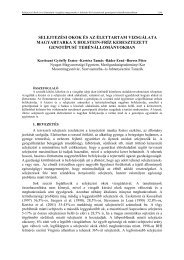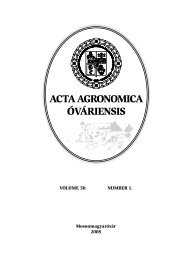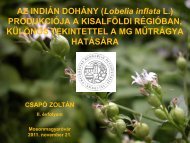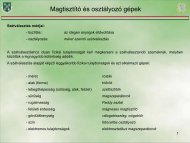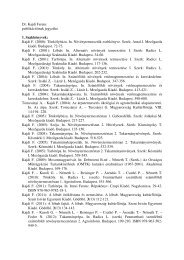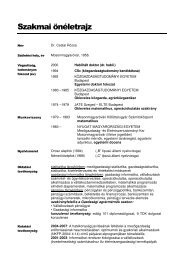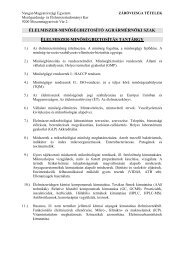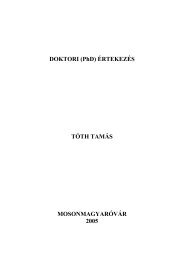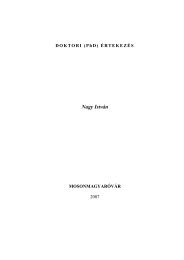teljes anyag - Nyugat-Magyarországi Egyetem Mezőgazdaság
teljes anyag - Nyugat-Magyarországi Egyetem Mezőgazdaság
teljes anyag - Nyugat-Magyarországi Egyetem Mezőgazdaság
Create successful ePaper yourself
Turn your PDF publications into a flip-book with our unique Google optimized e-Paper software.
The main issues of land consolidation in Hungary, with special regard...69Land policy has a significant importance in the European Union – especially in its westernpart. The land policy is determined by the Common Agricultural Policy (CAP) andthe national agricultural policy of the member states in the EU. The community rules– acknowledging the special importance of land ownership and land use – don’t regulatethe land use directly or rather just exceptionally. Therefore land policy lines up for several– often – contradictive aims. The rank of aims is different in the member states; it modifiesas time goes by and circumstances change. The main efforts according to Szûcs et al.(1997) are the following ones:– Establishing, sustaining and modernizing family farms with viable size;– Preserving the population supporting ability of rural regions in terms of agriculture,according to this the stabilisation and development of small and medium size farmingunits;– Protecting the land (environment) as well as limiting the land use (productionincrease).Land is mainly in private ownership in countries with a developed agriculture like theEuropean Union member states. Primarily the predominance of national regulation is characteristicfor the situation of land ownership in the EU, which on one hand side guaranteesthe suverinity of ownership right; on the other hand the owner (tenant) has to strictly meetthe social, economic and ecologic needs resulting from land use. (Vajda 1997) Thereforeland ownership and land lease is regulated with different degree restrictions in the memberstates. The state regulations can go as far as land ownership size and acquisition, farmsize, production structure and technology, land use, trade, as well as quantity and qualityprotection to enforce national interest.There are three general rules within the EU considering land ownership (Burgernéé 1998,Posta 2002):– Limitation of land property acquisition in order to avoid monopoles;– A rule which holds up fragmentation for land property viability reasons;– Each country’s regulation has to be valid for the other member states’ citizens, too.The first and second aim has to be underlined. The later refers to the limitation of landproperty acquisition; the rule of minimal land property size which has to be kept togetherand each member state regulates it – at a different degree. Besides the regulation of inheritance,the land redistribution procedure is the efficient antidote to fragmentation inthe whole EU, which is assured a normative subsidy by the Union. Advantages from landconsolidation are positive for both farmers and national economy: production costs sinkand efficiency grows as the cut up areas are terminated. (Kacz2007)Tanka (2000) refers to the following national land right which has made the agriculturalplant the common regulation unit for land ownership and land lease in many memberstates. In this system the state interferes in the conditions of land ownership acquisitionand land lease in order to realize land policy aims. Glatz (2004) says: ”…land propertyhas to be agricultural plant centred”.




